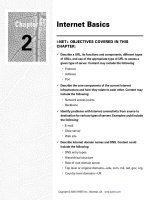Tài liệu Internet File-Sharing Technology pdf
Bạn đang xem bản rút gọn của tài liệu. Xem và tải ngay bản đầy đủ của tài liệu tại đây (216.5 KB, 10 trang )
INTERNET FILE-SHARING TECHNOLOGY
Group ICT-54B: Ta Quoc Viet, Tran Viet Anh, Pham Duy Hoan, Luc Quoc Quyen
TABLE OF CONTENTS
TABLE OF CONTENTS...............................................................................................................................................1
.................................................................................................................................................................. 4
Job Allocation
• Luc Quoc Quyen (20092161): Abstract (1) and Introduction (2)
• Tran Viet Anh (20090158): Technology (3)
• Pham Duy Hoan (20091134): Features (4)
• Ta Quoc Viet [editor] (20093262): Conclusion (5), Guide (6) and Reference (7)
1. ABSTRACT
Downloading is the most important
thing when you are using the Internet. It
is the simple truth that everyone who
has experienced in it knows. In
Vietnam, there are over 50,000,000
Gigabytes which were downloaded
from the Internet to computer each
month
[1]
. At the early days of Internet,
computer scientists have focused on
creating a new technology to help
people to share data with the best
benefit and the highest speed.
Nowadays, there are two technologies
which are the most popular in the
world. They are Direct Protocol and
Peer-to-Peer (P2P) Protocol. This essay
will provide a general knowledge of
each technology and some suggestion
to choose the best Download Programs.
2. INTRODUCTION
2.1. OVERVIEW
The essay was divided into 4 main
parts. Part I focuses on the History of
File-Sharing Technology. Part II
addresses the definition of each
technology and explains the differences
between them. Part III discusses some
good and bad features of Direct
Protocol and P2P Protocol. Part IV
explores how to use some popular
download programs via each protocol
and provides a brief conclusion.
2.2. HISTORY
When the 8-inch floppy disk was
developed by IBM, sharing files was
pretty easy – you copy the original data
files, and then borrow the disk.
Obviously, there were only a few
computers around back then, but this
happened again almost two decades
later, when optical and flash media
became nothing out of ordinary.
A few years later, in 1978, CBBS
becomes the first Bulletin Board
System (BBS)
[2]
, but BBS access is
limited to phone lines until early 1990s.
Anyway, almost two decades ago, BBS
was probably the most widely used file
sharing method.
INTERNET FILE-SHARING TECHNOLOGY
In 1979, Tom Truscott and Jim Ellis
came up with Usenet. It is a network
that was initially based on the UUCP
protocol for dial-up connections and
has, since being transported over the
Internet, used a specialized client-server
protocol, the Network News Transfer
Protocol (NNTP). Its main purpose was
the exchange of text based messages,
but through attachments allowed users
to encode files and distribute them to
participating subscribers of Usenet
Newsgroups. Usenet remains one of the
largest carriers of file sharing and
Internet traffic. Legal challenges to P2P
systems have spurred a resurgence of
Usenet. Usenet itself has also been the
target of legal challenges pertaining to
its use in file-sharing.
In 1985, the FTP protocol becomes
standardized, and in 1988, IRC is born.
In 1990, the real thing starts with the
formal proposal of the World Wide
Web, followed by the introduction of
the MP3 standard, at the end of 1991
[3]
.
In June 1999, Napster was released
as a centralized unstructured peer-to-
peer system, requiring a central server
for indexing and peer discovery. It is
generally credited as being the first
peer-to-peer file sharing system. In the
case of Napster, an online service
provider could not use the "transitory
network transmission" safe harbor in
the DMCA if they had control of the
network with a server. Many P2P
products will, by their very nature,
flunk this requirement, just as Napster
did. Napster provided a service where
they indexed and stored file information
that users of Napster made available on
their computers for others to download,
and the files were transferred directly
between the host and client users after
authorization by Napster. Shortly after
the A&M Records, Inc. v. Napster, Inc.
loss in court Napster blocked all
copyright content from being
downloaded.
Gnutella, eDonkey2000, and Freenet
were released in 2000, as MP3.com and
Napster were facing litigation. Gnutella,
released in March, was the first
decentralized file sharing network. In
the Gnutella network, all connecting
software was considered equal, and
therefore the network had no central
point of failure. In July, Freenet was
released and became the first
anonymity network. In September the
eDonkey2000 client and server
software was released.
In 2001, Kazaa and Poisoned for the
Mac was released. Its FastTrack
network was distributed, though unlike
Gnutella, it assigned more traffic to
“super nodes” to increase routing
efficiency. The network was proprietary
and encrypted, and the Kazaa team
made substantial efforts to keep other
clients such as Morpheus off of the
FastTrack network.
In July 2001, Napster lost in court
and was shut down. This drove users to
other P2P applications and file sharing
continued its exponential growth. The
Audiogalaxy Satellite client grew in
popularity, and the LimeWire client and
BitTorrent protocol were released. Until
its decline in 2004, Kazaa was the most
popular file sharing program despite
bundled malware and legal battles in
the Netherlands, Australia, and the
United States. In 2002, a Tokyo district
2
Group ICT-54B – Ha Noi University of Technology. Ha Noi May 30, 2010
INTERNET FILE-SHARING TECHNOLOGY
court ruling shut down File Rogue and
an RIAA lawsuit effectively shut down
Audiogalaxy.
From 2002 through 2003, a number
of popular BitTorrent services were
established, including Suprnova.org,
isoHunt, TorrentSpy, and The Pirate
Bay. In 2002, the RIAA was filing
lawsuits against Kazaa users. As a
result of such lawsuits, many
universities added file sharing
regulations in their school
administrative codes (though some
students managed to circumvent them
during after school hours). With the
shutdown of eDonkey in 2005, eMule
became the dominant client of the
eDonkey network. In 2006, police raids
took down the Razorback2 eDonkey
server and temporarily took down The
Pirate Bay. Pro-file sharing
demonstrations took place in Sweden in
response to the Pirate Bay raid. In 2009,
the Pirate Bay trial ended in a guilty
verdict for the primary founders of the
tracker.
3.TECHNOLOGY
3.1. DEFINITION
Those are clearly definition of 2
most usual file sharing protocols:
• A peer-to-peer, commonly
abbreviated to P2P, is any distributed
network architecture composed of
participants that make a portion of their
resources (such as processing power,
disk storage or network bandwidth)
directly available to other network
participants, without the need for
central coordination instances (such as
servers or stable hosts)
[4]
.
• Client–server model of
computing is a distributed application
structure that partitions tasks or
workloads between service providers,
called servers, and service requesters,
called clients.
[5]
3.2. DIFFERENCES AND
SIMILARITIES
In P2P, Peers are both providers and
consumers of data, in contrast to the
traditional client-server model where
only servers upload, and clients
download. A similarity, Some P2P
systems have a central server that was
connected with all nodes. But the
server only tracks, indexes peer’s IP
address and uses those data for expand
its network by sending IP address list to
peers. In fact, a pure P2P network
doesn’t have the connection of client –
server but only node-node that
functions as both ways upload and
download on the network.
Peer-to-peer was used in
VoIP, Real-time chat,
HDTV online, etc…
Especially, it was
popularized by File-Sharing
systems such as eDonKey,
BitTorrent, Gnutella.
Direct download use
Client-server model to
request download and
transfer data from server
to client via FPT, HTTP.
3.3. CATEGORIES
3.3.1. Peer To Peer Networks
Some of the most popular options
for file sharing on the Internet are peer-
3
Group ICT-54B – Ha Noi University of Technology. Ha Noi May 30, 2010
INTERNET FILE-SHARING TECHNOLOGY
to-peer networks, such as BitTorrent
and eDonkey network.
Users can use software that connects
into a peer-to-peer network to search
for shared files on the computers of
other users (i.e. peers) connected to the
network. Those files can be
downloaded directly from other users
on the network. Typically, large files
are broken down into smaller pieces,
which may be downloaded from
multiple peers and then reassembled by
the downloader. At the same time, the
peer is uploading the pieces it already
has to other peers. Even after download
completed, user can upload that data to
others to support their downloading
speed.
Nowadays, BitTorrent become the
Number.1 file sharing network on the
internet. It has been estimated that it
may account for roughly 27-55% of all
Internet traffic (depending on
geographical location) as of February
2009
[6]
.
Programmer Bram Cohen
designed this protocol in
April 2001 and released a
first implementation on 2
July 2001.
[7]
The reasons BitTorrent become
popular because of its convenient.
Users can publish their data or
download other user data fast and easy
by torrent client programs. They
package all information of data in a
torrent file (.torrent) and then publish it.
Other users download that torrent file
and run it by any torrent client to
download data piece by piece. In
addition, there are many torrent tracker
(a kind of central server) support user to
find as many peers as possible which
are downloading same data. For
example: Isohunt.com, SuperNova.org,
ThePirateBay.org, etc…
3.3.2. File Hosting Services
File hosting services are a simple
and traditional Client-server model
method to download file, video, and
any kind of data that is not webpage.
Internet users can download data
directly from file hosting services by
using download links (http, ftp) that are
provided by service sites. These sites
allow web and FTP access for users to
manage or get download link. They can
be optimized for serving many users
(hosting) or only for single-user
storage. Related services are video
sharing, photo sharing, virtual storage
and remote backup.
Two of the most popular file hosting
services:
MediaFire (i.e. MF)
MegaUpload (i.e. MU)
A video sharing service is
provided by MegaUpload that can
stream video files were stored at host:
4.FEATURES
4
Group ICT-54B – Ha Noi University of Technology. Ha Noi May 30, 2010
INTERNET FILE-SHARING TECHNOLOGY
4.1. PEER-TO-PEER NETWORK
(P2P)
4.1.1. Advantages
Because of the principle of peer
structure, this protocol has many
advantages compared to other
commercial networks. In peer-to-peer
network, all machines involved provide
resources, which may include
bandwidth, storage space, and
computing power. So the more
machines join the network, the stronger
overall ability of the network becomes.
As nodes arrive and demand on the
system increases, the total capacity of
the system also increases
[8]
.
Decentralization of peer networks also
helps the networks work well even
when some machines have problem.
Thus, searching for and sharing
resources become more quickly and
effective.
4.1.2. Disadvantage
But users who use P2P also have
some problems when they join the
networks. The most important problem
is that consumers can be faced with a
number of risks when they download
and use commercial P2P file-sharing
software programs
[9]
. A file-sharing
program which users download and use
include other software, such as spy
ware or adware. So they may
inadvertently share sensitive personal
files residing on their hard drives. Users
can also receive dangerous viruses with
files and programs when sharing files
using P2P programs
[10]
. And viruses
can impair the operation of their
personal computers. So it’s very
dangerous that your computer may be at
risk at any time. Finally, because of the
way files are shared in network, users,
especially children may be exposed to
unwanted pornographic images or
movies.
4.2. CLIENT-SERVER
NETWORK
4.2.1. Advantages
User (client) also can only
download files or programs directly
from the servers through client-server
network. In this case, there are many
clients (users) but they just are the
consumers. Servers are the suppliers.
All resources are stored in these servers
and users can download them from
servers or upload to servers. In contract
to P2P, users are not allowed to share
resources directly with others one, it
means all computers must connect to
only one server. In this situation, users
can download directly files or programs
from the servers and do not depend on
the numbers of computer involved in
the network. So that users may get the
resources conveniently. And users may
not face some problems with viruses or
personal files like P2P because with this
protocol, the security of data will be
higher than P2P.
4.2.2. Disadvantages
But this protocol has some
disadvantages because of its principle.
If there is only a fixed numbers of
servers, while there are too many
clients participate in the network, the
data transfer capability will be reduced.
The more client network has, the less
speed data will be transferred. In
addition, if the servers are crashed, the
whole system network will be stalled. It
5
Group ICT-54B – Ha Noi University of Technology. Ha Noi May 30, 2010









